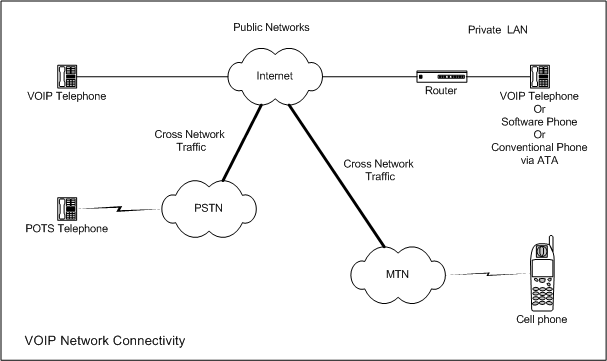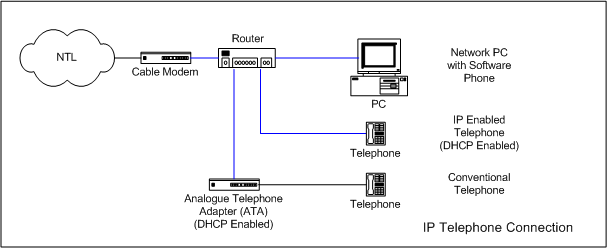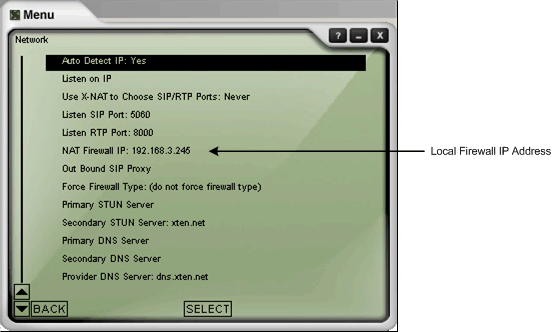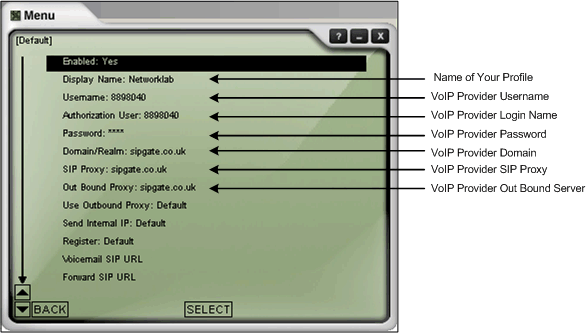VoIP
VoIP, or Voice Over IP to give it it's full name, is basically telephony services over the public Internet using TCP/IP. A conventional telephone will have a wired connection to a local telephone switch and will generate a switched connection over the public telephone network. In a VoIP connection, the connection is converted to TCP/IP and then made across the Internet.
VoIP can be used just like a conventional telephone service, so it can be used to connect to other VoIP phones, conventional phones on the PSTN, or POTS (Plain Old Telephone Service), and Mobiles, as shown below. VoIP telephones can be physical phones, that look just like conventional telephones, or they can be 'soft' phones that reside as software on a PC. The PC used in this way requires a sound card with speakers and a microphone, which can be in the form of a headset or VoIP telephone connected to a soundcard or via USB.

One huge benefit VoIP provides is that for some connections there is no cost for calls made. These connections are normally those made to the same network, i.e., another user of the same VoIP service as the originator with call charges incurred when crossing to other networks such as the PSTN or Mobile networks. Charges may also be incurred when connected from one VoIP provider to another. Typically providers will offer quantities of times for monthly fees, in much the same way as fixed fee mobile phone contracts.
Although VoIP has been around for a few years with products such as NetMeeting or MSN, where the remote user had to have the same application as the caller had, there are still issues concerning implementations of the services available which can result in incompatibilties between some providers implementations of VoIP services. The IETF (Internet Engineering Task Force) has been involved in developing a standard for VoIP called SIP (Session Initiated Protocol), which is becoming the accepted protocol for Internet telephony.
VoIP Providers
SIP-based providers:
Non SIP Providers:
- Skype
Skype is an extremely popular VoIP service that uses a proprietry protocol based around P2P technology.
VoIP Hardware
VoIP is an extremely versatile application. It can be used via an application on a PC, thru' a VoIP phone, or even a conventional telephone connected either to a SIP-enabled router or an Analogue Telephone Adapter, or ATA. Some routers are also available that provide an RJ11 socket so that a conventional phone can be connected directly to the router, although an adapter may also need to be used if the telephone has a standard 'BT' or RJ12 plug. Some of these hardware solutions are shown in the diag below.
If you are a Skype user it is possible to obtain phones and routers that are compatible with the Skype service.
VoIP Software
Some VoIP providers supply their own software (Skype especially, as their software is proprietry) but one application that is often recommended is
X-Lite.
X-Lite can be at first look complicated to set-up due to the number of options but in reality there are only two areas of configuration that are need to be set up. These are the Network and SIP Proxy setups. The following screendumps show these areas and the settings that are required. The screendumps are for a Sipgate account.
X-Lite Network Setup
Most of the settings on this page can be left at default with just the Firewall IP address being set. Note, this will need to be set to the IP address of the local Network gateway, not the address shown here:
X-Lite SIP Proxy Setup
This screen should reflect the settings required to connect to the VoIP provider. Again, the details shown are for a Sipgate account. The appropriate information will need to be entered for the VoIP provider being used.
VoIP and Firewalls
NAT and software firewalls can cause some disruption to VoIP due to the number of ports that some software requires. Simple NAT found on most domestic Routers does not really cause much disruption but more intelligent security may require some incoming ports to be forwarded to the PC running the software. In some extreme cases, it may be necessary to place the PC as a DMZ host however the risk of doing this cannot be underestimated. If a software firewall is used on a PC, then it may be necessary to configure some rules on that in order to allow VoIP services.
The Skype client generates a random port for it's communication when it is installed and this port may need to be forwarded thru' any firewalls. X-Lite, OTOH, utilizes a number of ports for the SIP (UDP 5060) protocol as well as for the RTP (udp 8000) and RTCP (UDP 8001) protocols used for transporting the audio and video over the network and again, these may need to be forwarded thru' any firewalls or NAT devices that are installed. Other ports above 8001 may also be required.
Additionally, if a STUN (Simple Traversal of UDP Through NAT) server is used there may also be a need to allow the ports necessary for this service as well, these being UDP and TCP port 3478, although some providers such as Sipgate run their STUN server on UDP port 10000. The purpose of a STUN server is to allow STUN aware clients to determine the ports used by the NAT device that it resides behind as well as the type of NAT that is in use by that device.
Further Reading
Skype Me!
SIP: 01438898040
©
Nig's Net Written using the Bluefish HTML Editor on RedHat 9.0.
All Copyrights and Trademarks ACK'd. Not to do so would be a SYN!




